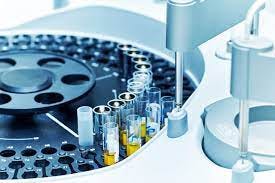IVD stands for In-Vitro Diagnostic, which refers to medical tests or devices that are performed outside of a living body, usually in a laboratory setting or on a sample of bodily fluid or tissue. These tests are used to diagnose or monitor medical conditions and include procedures such as blood tests, urine tests, and tissue biopsies.
The IVD market is segmented into various categories based on product type, technology, end-user, and geography. Some common segments in the IVD market are:
- Product Type: Reagents and Kits, Instruments, and Software and Services.
- Technology: Immunoassay, Clinical Chemistry, Molecular Diagnostics, Microbiology, Hematology, and others.
- End-user: Hospitals and Laboratories, Point-of-Care Testing, and Home Care.
- Geography: North America, Europe, Asia-Pacific, Latin America, and Middle East & Africa.
These segments help in identifying the market size, growth rate, and target audience for the IVD market.

The US IVD (In-Vitro Diagnostic) market is expected to grow significantly in the coming years due to various factors such as the increasing incidence of chronic diseases, the growing aging population, advancements in technology, and increasing demand for point-of-care testing.
According to recent market research reports, the US IVD market was valued at around $18 billion in 2020 and is expected to grow at a compound annual growth rate (CAGR) of around 5% from 2021 to 2028. The molecular diagnostics segment is expected to grow at the highest rate during the forecast period, driven by increasing demand for COVID-19 tests.
However, the growth of the IVD market in the US may be impacted by factors such as the shortage of raw materials, high costs associated with IVD tests, and regulatory barriers. Nevertheless, the growing demand for personalized medicine and increasing investment in research and development in the IVD sector is expected to drive the market growth in the future.
IVD stands for In-Vitro Diagnostics, which refers to medical tests or devices that are performed outside of a living body, usually in a laboratory setting or on a sample of bodily fluid or tissue. These tests are used to diagnose or monitor medical conditions and provide crucial information about a patient’s health status.
IVD tests can be performed using a variety of technologies, including immunoassay, clinical chemistry, molecular diagnostics, microbiology, hematology, and others. Some common examples of IVD tests include pregnancy tests, cholesterol tests, glucose tests, and tests for infectious diseases such as HIV and hepatitis.
The IVD market has experienced significant growth in recent years due to the increasing incidence of chronic diseases, the growing aging population, advancements in technology, and increasing demand for point-of-care testing. In addition, the COVID-19 pandemic has further driven the demand for IVD tests, particularly for molecular diagnostics tests.
IVD tests are performed by hospitals, laboratories, and other healthcare facilities, and can also be performed by patients themselves at home using home-use IVD tests. The IVD market is highly regulated to ensure the accuracy and safety of the tests, and companies must comply with various regulatory requirements, including approval from regulatory bodies such as the US Food and Drug Administration (FDA).
Overall, IVD plays a crucial role in the diagnosis and management of medical conditions, and is expected to continue to grow in the coming years as advancements in technology and increasing demand for personalized medicine drive the market growth.
0 Comments